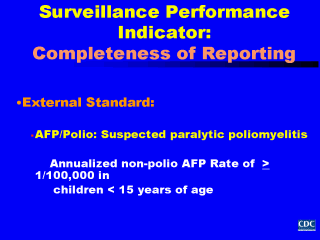| front |1 |2 |3 |4 |5 |6 |7 |8 |9 |10 |11 |12 |13 |14 |15 |16 |17 |18 |19 |20 |21 |22 |23 |24 |25 |26 |27 |28 |review |
 |
Now that we are aware of some of the reasons why all actual cases of disease may not be reported to our surveillance system, letís review of the surveillance performance indicators which can help us determine how complete our case reporting actually is. There are several types of surveillance performance indicators which can be used for this purpose. The first type of indicator is an external standard, or an indirect measure of incidence for the disease of interest. An example of this type of indicator is the annualized non-polio incidence for acute flaccid paralysis, or AFP, observed among children less than 15 years of age. As part of the effort to eradicate poliomyelitis, this surveillance performance indicator has been adopted by countries in which wild poliovirus is still endemic to assess their completeness of reporting of suspected cases of wild poliovirus infection. While we are actually interested in completeness of reporting for cases of wild poliovirus infection, such cases are hard for health care providers to identify and clinically diagnose directly. Instead, we conduct surveillance for a condition, AFP, which is much easier to detect clinically, and ask health care providers to report these cases to our surveillance system. We know that even in the absence of paralysis due to wild poliovirus infection, the baseline incidence of AFP due to Guillain-Barre Syndrome and other causes is fairly constant over time, i.e., at least one case per 100,000 children under 15 years of age. When countries or regions achieve reported AFP incidence at or exceeding this level even in the absence of any laboratory confirmed or clinically compatible AFP cases due to wild poliovirus infection, we can be reasonably confident that the absence of reported poliomyelitis in fact means there is no wild poliovirus circulating. We know our surveillance efforts are being conducted with sufficient intensity to be able to detect any cases of infection should they actually be occurring. If AFP rates within a region or country are less than one per 100,000 children under 15 years, we cannot be certain if the absence of reported cases of poliomyelitis is due to a true absence of wild poliovirus circulation or inadequate surveillance efforts. In this situation, we would track AFP surveillance at the regional and national level, identify areas with inadequate surveillance, and make improvements in the surveillance system so that AFP incidence rates met or exceeded one per 100,000 in children under 15 years of age. Looking at external standards helps us realize when our surveillance efforts need to be intensified or improved. After cases of AFP clinically consistent with poliovirus infection are reported to the surveillance system as suspected cases of poliomyelitis, laboratory testing of stool samples occurs to rule in or out wild poliovirus infection. For cases in which adequate laboratory testing is not obtained for this purpose, they are classified as compatible with poliovirus infection and thus, not included in the calculation of the non-polio AFP rate. These circumstances are considered a failure of case investigation and surveillance. |
| front |1 |2 |3 |4 |5 |6 |7 |8 |9 |10 |11 |12 |13 |14 |15 |16 |17 |18 |19 |20 |21 |22 |23 |24 |25 |26 |27 |28 |review |